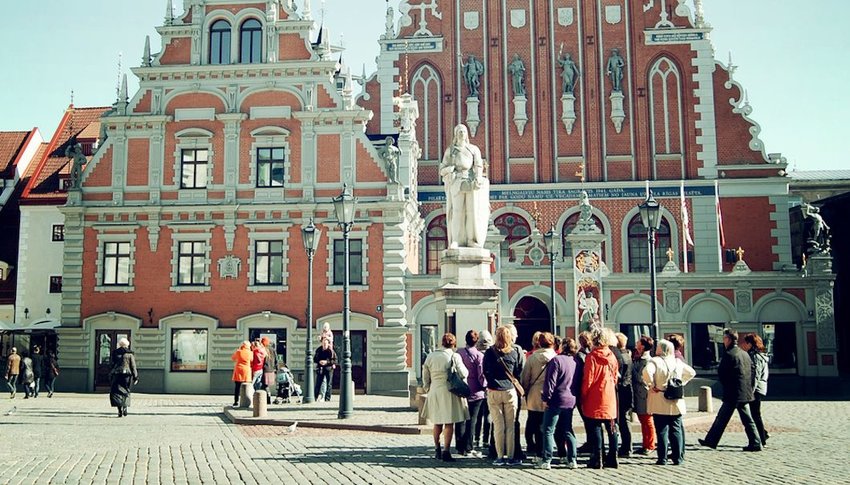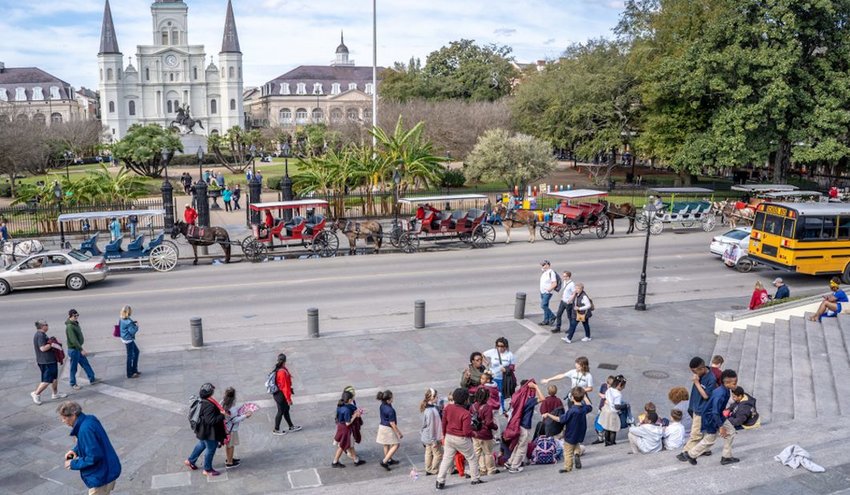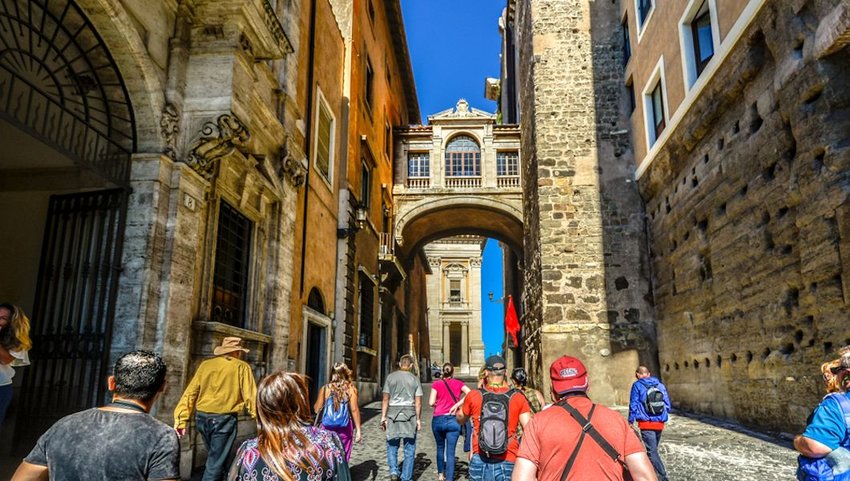It was my first time traveling solo — and I wasn’t quite sure where to start. I had chosen Stockholm as my trial city since it felt walkable and safe. In preparation for this solo adventure, I had studied every map and guidebook, but all that information suddenly felt overwhelming as I walked from the bus station to the Story Hotel, where I was staying.
In my research, I’d come across a free walking tour run by Free Tour Stockholm, but I was hesitant about joining a group tour by myself. Nevertheless, the next morning, I decided to scout it out. Since I didn’t have to pay ahead of time, I could decide on the spur of the moment if I wanted to join or not.
Before I even got to the meeting point, I could see the guide smiling, welcoming me in. He greeted me and asked where I was from, how long I’d be in Stockholm, and what I was interested in seeing and doing.
Immediately, I was at ease, and decided to join the others on the tour. As we walked around town we learned about the Swedish capital’s history, spotting landmarks like the concert hall where the Nobel Prize is handed out and the bank where Stockholm Syndrome originated. Over the course of 90 minutes, I figured out the lay of the land, learned the historical significance behind the essential landmarks, and discovered cultural norms I wouldn’t have thought to ask about — for instance, the reason we saw so many new mothers with strollers in Kungsträdgården (King’s Garden) was because Sweden allows up to 480 days of maternity leave.
Between stops, I chatted up the rest of the tour group, which included families with young kids, retired couples, and so many other solo travelers of all ages, hailing from Asia, Europe, and North America. We swapped recommendations on how to maximize our time in the city — and I even found myself dishing out advice on how I scored such a good deal on Royal Swedish Opera tickets.
Less than two hours later, I had exactly the right grasp of geography, history, and cultural happenings that I needed to explore on my own. Plus, our tour guide Kevin gave us a local tip that the best fish soup in town was hidden in the basement of a food hall at a shop called Kajsas Fisk. Soon enough, I was among locals, indulging in one of the tastiest meals — and best deals — I had on the trip.
And all that knowledge was gathered on a walking tour I didn’t even pay in advance for. Now whenever I go to a new city, the first thing I do is look up “free walking tours.” I’ve since joined them on four continents — on my own in Austin, Adelaide, Gdansk, Helsinki, Quito, Rio de Janeiro, Rome, Savannah, Sydney, and Warsaw; with friends in Krakow, Porto, and Lisbon; and even with my parents in Reykjavik.
Since there isn’t one overarching organization that does them worldwide, the specifics of these tours varied. Some charged a small reservation fee while others recruited tourists along the way with their brightly colored umbrellas.
But the things they all have in common are quality and no price tag.
How Did Free Walking Tours Start?

The concept of a free walking tour is simple: Join the tour at a set time and place, and at the end, tip what you feel it was worth.
Tracing back the history of this model, all signs point to Chris Sandeman as the brain behind the business concept.
“The free tour concept had been percolating inside me for a little while,” says Sandeman, who now runs SANDEMANs New Europe with free tours in 20 cities worldwide, from Jerusalem to New York. The Yale graduate had worked at a traditional paid walking tour company in Berlin and was taken aback by how many people would give negative feedback about their experiences. “I was so enamored with Berlin and wanted to desperately increase the number of people benefiting from a tour because I didn’t want them to miss out on the city. It became clear that the best way to increase access to tours in Berlin was to eliminate any barriers to entry.”
So he came up with the business model of allowing travelers to pay on the backend.
“Based on my interactions, I saw that the travelers least likely to want to pay for a tour ahead of time were also most likely to appreciate a walking tour once they were on one,” he says. So in 2003, he started by offering the service to the Meininger Hotels. Six weeks later, he had a dozen hotels spreading the word. Now, his tours have been among the top tours in Berlin for the last 17 years.
The model started spreading — first in Europe and then globally. Icelander Marteinn Briem learned about the concept while backpacking around the world for six months, so when he returned home to Reykjavik, he launched a free walking tour called City Walk, which he now runs full time as the CEO. (It even has the endorsement of soccer megastar David Beckham!)
Even though he grew up there, Briem still did his homework before his launch in 2014. “I've read every single book there exists about Reykjavik's architecture and history. I've definitely learned a lot in the past years while giving tours,” he says.
He started with free tours, but with Iceland’s rise in popularity, he now also offers prepaid ones for a small-group experience. Indeed, these tours have become so popular, I remember trailing a good 30 or 40 people on my free tour as we learned the truth about elves and vikings. The witty guide was so engaging that his joke about Iceland’s treeless terrain has stuck with me all these years (“What do you do when you get lost in an Icelandic forest? Stand up!”) — and he charmed my parents so much that they had no problem digging deep into their wallets at the end.
Bringing Free to the U.S.

Throughout my travels, I've found the most free walking tours in Europe, as well as South America and Australia. In recent years, though, they’ve been springing up here in the U.S. as well. As more Americans experience these free tours abroad (Briem says about one in four people on his Reykjavik tours are from the U.S.), some have brought the concept back home.
In 2014, I hopped on one in Austin, which was run by the Austin Visitor Center (and now costs $10 a person). But it wasn’t until I went to Savannah in 2017 that I found a tour exactly like the European model. Sure enough, Savannah native Chris Rauers had received a crash course in tourism working as a guide in Rome before bringing free walking tours to his hometown.
“Savannah has become a mecca for tourism, but it came up quietly and slowly — it was like a word-of-mouth destination,” he says. “But being from here, I had an ‘in’ to various segments of society.” Business-wise, he was confident the concept would work here. “We have a gratuity culture here in the U.S. that doesn’t exist in other countries.”
Sure enough, as soon as he launched Free Savannah Tours, it was a hit. Ninety percent of the tourists were Americans, with Californians and New Yorkers among the most frequent. He says bookings average 2.5 people, with couples and families in their 20s to 50s being the most common. “You get a vast array of people, but everyone’s relatively intelligent and well-traveled.”
Still, while free walking tours do also exist in Charleston, Boston, New York and Philadelphia, the idea hasn’t spread here the way it has in Europe. And Rauers says it comes down to urban development.
“In Europe, you can do a walking tour everywhere — a lot has to do with their history and the logistics of the city since everything is walkable,” he says. “There's only a few walking cities in the United States since we’re a relatively new country and have urban sprawl.”
But fortunately for Rauers, the large historic district in Savannah is the perfect design. While he’s had to adjust his business model since people were booking spots and not showing up (now they charge $2 a person ahead of time), it continues to be one of the top-ranked attractions on TripAdvisor.
The Advantages of Free Tours

No matter what time of day you arrive in town, there’s usually a convenient tour time. Most companies run seven days a week, with at least one morning departure and one afternoon departure. Some in bigger cities offer three (or more) departures a day — and some even have evening tours.
While the non-committal aspect helps with travel planning, the free model also allows for flexibility. For instance, I was only able to join a tour in Adelaide for 30 minutes before I had to leave for the airport, so I simply let the guide know in between stops, tipped him accordingly and ran off. I’ve often seen others join midway or hop off halfway as well.
Another time, I was being overly ambitious with my itinerary in Warsaw and didn’t think I’d make it back in time from a day trip to Chopin’s birthplace in Żelazowa Wola when sudden downpours caused us to get stuck in traffic. But I zipped over to the tour’s meeting spot at Sigismund's Column and found the group hiding from the rain in a train station (yes, most run rain or shine), so I only missed the introduction.
Some cities also have multiple companies running free walking tours. I’ll usually mark down all the times and meeting points for each one — and if I miss one, like I did in Helsinki, I'll just join another.
Another advantage is that the tours often point out local traditions that you might not recognize by sight. In Warsaw, I walked by the Old Wishing Bell several times and never gave it a second look. But when I went with my guide, she led us through a very precise process to ensure good luck, which involved hopping on one leg. (Hopefully she wasn’t just trying to see how gullible I was!)
Rauers also notes that the style of exploration can be more compelling than some more formal city tours. “The real point of a walking tour is that it’s much more intimate,” he says, adding that they’re also efficient. After all, most travelers have limited time, so his 90-minute tours ensure you hit all the highlights, including unmarked sites you might breeze by, like the 150-year-old Live Oak Trees and the square where Tom Hanks sat on the Forrest Gump bench. “You can hear the stories, you can ask questions, you can go up to the front and ask the guide where the good bars or restaurants are.”
Most free walking tour companies offer a tour of the city’s main highlights, which vary in time and length depending on the geography, but are typically between 90 minutes to two and a half hours and usually don’t involve more than two miles of easy-paced walking. Other companies, like Free Walkative Tour in Gdansk, also have themed tours. On the Main Town Tour, the Polish city’s history was told in such an enthralling way as we saw the crucial sites in the city center, but ended with a cliffhanger with the destruction of Gdansk. So I had to hop on their afternoon Solidarity Tour to learn the modern side of the city’s history. The company also offers other themed routes like one tracing the Battle of Westerplatte and one that explores the history of the Nazi movement during WWII.
Often after a free tour, I’ve also used the guide as my local sounding board — I’ll ask if it’s worth going to a particular site or whether the weather will affect my plans. And sometimes I’ve made new friends in the process. After our tour in Lisbon, a solo traveler overheard the guide recommending a restaurant to my friend and me, so he joined us — and now we have a new friend in England as well.
“When you love a place, it’s based off of pure feeling and pure visuals, but getting context behind it facilitates even more interest,” Rauers muses.
And I’ve found the same — as an alum of more than a dozen free walking tours, I think the truest benefit is having an open forum to understand where you are and be able to ask all your questions. Instead of wondering what that ornate building is, why the water fountain isn’t running, or why the mailboxes are a certain color, you can get the low-down from a local who cares enough to share their city with strangers every day. And there’s no better way to put the city in context before you head out on your own.
“Free tours are spreading around the world,” Sandeman says. “No matter where you go, people who travel have the opportunity to learn more and are bound to have more in common than not with the people they meet — and those bridges foster understanding and compassion.”





